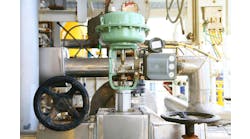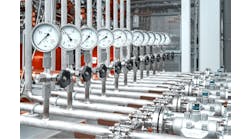QUESTION:
Kindly suggest a suitable control valve for the following application: the slurry has a required flow rate of 800 kg/hr to 1,500 kg/hr through a pipeline of 150 mm nominal bore. The slurry is neutral, but explosive, and has a viscosity of approximately 10,000 cps and a medium temperature of approximately 30 °C. Particle size is approximately 350 microns. The end connection on the pipe is flanged, and the gasket is according to process material. The valve is one piece for hazardous area application.
The process can be activated manually or by a servo valve that produces pneumatic control in response to an electrical signal input. It takes place under a 3 torr to 5 torr vacuum.
The slurry is transferred from one vessel to another via gravity, and we have to control the transferring rate as per process requirement from 800 kg/hr to 1500 kg/hr. The valve should be pneumatically operated, as we have to operate the valve from a remote control room. It should be equipped with a handle for manual operation. Since the complete operation is under vacuum, tight shutoff is required.
Praveen Tandon, Instrumentation Engineer, India
ANSWERS:
When the process stream is highly flammable, explosive, viscous and contains solids in suspension, the flow path through the control valve should be unobstructed and streamlined. The packing design also should be carefully selected to keep out the solid particles. Good sealing can be obtained by backing up the packing with a bellows seal or by selecting a valve that has no packing box at all. Not knowing your valve characteristics and rangeability requirement, I can’t select a specific valve type. Therefore, I will list a number of slurry valve designs and note the main features of each.
The chief difficulty encountered with heavy slurry streams is plugging. Conditions that contribute to plugging include a treacherous flow path, shoulders, pockets or dead-end cavities. Valves with these characteristics provide potential areas for solids to accumulate, settle out, gel, freeze, solidify, decompose and plug the valve. Therefore such designs must not be used.
The ideal slurry valve has the following features:
- When the valve is open, it provides full pipeline opening.
- When throttling, it provides an unobstructed and streamlined flow path.
- It has high pressure and temperature ratings.
- It is available in corrosion-resistant materials.
- It is self-draining.
- It will fail safe.
- Its rangeability and flow characteristics are acceptable for the application.
- The actuator stem is positively sealed from the process.
Unfortunately, no one valve meets all these requirements. Therefore the process control engineer has to weigh which of the above features are essential and which are not.
For example, if it’s essential to provide a full pipe opening when the valve is open, the pinch valve designs (see A, Figure 1 below), the full-opening angle valves (B), some of the Saunders valve designs (C), and the full-ported ball valves can be considered. Naturally, the other valve features must also be considered.
FIGURE 1: VALVES FOR SLURRY USEPinch valves, for example, aren’t suited for vacuum service, and are limited in material of construction options, pressure, temperature ratings, flow characteristics, speeds of response and rangeability, but they do provide a self-cleaning streamlined flow path and a characteristic that resembles a variable Venturi.
Saunders valves and pinch valves have similar features, but I wouldn’t recommend them for vacuum service because the inner vacuum makes it difficult to open them. On positive pressure service, these designs provide good sealing because they have no stuffing boxes. Saunders designs are superior to pinch valves if corrosion-resistant materials are needed, but they’re inferior if completely unobstructed stream-line flow is desired. Pinch valves are suitable for very low pressure drop services only, while Saunders and wedge plug valves can operate at slightly higher pressures.
Lined butterfly valves are a good choice if the process pressure is high while the valve drop is low.
The angle valve with a scooped-out plug satisfies most requirements, except that its flow characteristics are poor, and it’s necessary to purge the stem above the plug to prevent solids from migrating into that area.
Full-ported ball valves provide full pipe opening in their open position, but when throttled, both their flow paths and their pressure recovery characteristics are poor.
Valves that don’t open to the full pipe diameter, but still merit consideration in slurry service include characterized ball valves, the various self-draining designs, the eccentric disc type rotating globes, and the sweep angle valves.
The characterized ball valve, for example, exhibits an improved flow characteristic in comparison with the full-ported ball type. It’s well-suited for process fluids containing fibers or larger particles. The self-draining valve allows slurries to be periodically flushed out of the system. Complete drainage is guaranteed because all surfaces are sloping downstream.
The sweep angle valve, with its wide-radius inlet bend and its Venturi outlet, is similar to the angle slurry valve. Its streamlined non-clogging inner contour minimizes erosion and reduces turbulence. To prevent process fluid from entering the stuffing box, a scraper can be furnished, which can also be flushed with a purge fluid if necessary. The orifice located at the very outlet is built like a choke fitting. Both orifice and plug may be made of abrasion-resistant ceramic or other hard metals.
For slurries with large particles, the ideal orifice shape is a circle, such as that of an iris valve or a jacketed pinch (A).
Orifice size, particle size and required rangeability are interrelated. For any particle size and orifice shape there is a minimum opening below which plugging will occur. To get good rangeability (good control at low flow rates) the valve Δp should be small and constant. One way to provide this is by the use of a “head box.”
Béla Lipták
I agree with your suggestions and have an additional point to suggest to Praveen Tandon.
If a slurry is such that it will accumulate particles in the trim of the valve, I’ve found that a fully open command lasting few seconds and issued from time to time (15 to 30 minutes) will clean the internal of the valve, and prevent build up of solids, reestablishing good control characteristics. This command can be obtained via a solenoid valve on the pneumatic line to the actuator or from the DCS. However I wouldn’t suggest this possibility if the valve is equipped with a bellow seal, due to the shortening of its life.
Alberto Rohr, Consultant, Italy
A pinch valve is out because of vacuum. A V-ball valve with hardened trim is the best selection. The valve would be rather small in size, so replacing it eventually should be no problem.
Stephan Gaertner, Sales Engineer, Clipper Contols
| Ask the Experts |
“Ask the Experts” is moderated by Béla Lipták ([email protected]), editor of the three-volume Instrument Engineer’s Handbook, 4th edition (available from Amazon.com) He is the former chief instrument engineer of C&R (later John Brown) and is recipient of ISA’s 2005 Life Achievement and Control’s 2001 Hall of Fame award. In this column, he welcomes questions about problems in the fields of process control and automation.




